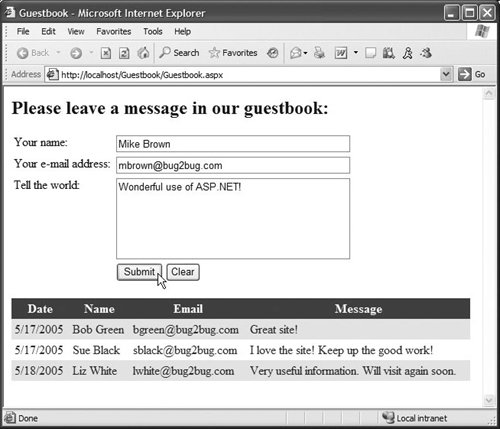Case Study: Connecting to a Database in ASP.NET
Case Study Connecting to a Database in ASP NET
Many Web sites allow users to provide feedback about the Web site in a guestbook. Typically, users click a link on the Web site's home page to request the guestbook page. This page usually consists of an XHTML form that contains fields for the user's name, e-mail address, message/feedback and so on. Data submitted on the guestbook form is then stored in a database located on the Web server's machine.
In this section, we create a guestbook Web Form application. This example's GUI is slightly more complex than that of earlier examples. It contains a GridView ASP.NET data control, as shown in Fig. 21.33, which displays all the entries in the guestbook in tabular format. We explain how to create and configure this data control shortly. Note that the GridView displays abc in Design mode to indicate string data that will be retrieved from a data source at runtime.
Figure 21.33. Guestbook application GUI in Design mode.
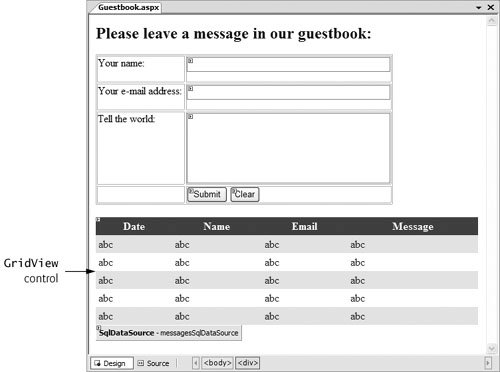
The XHTML form presented to the user consists of a name field, an e-mail address field and a message field. The form also contains a Submit button to send the data to the server and a Clear button to reset each of the fields on the form. The application stores the guestbook information in a SQL Server database called Guestbook.mdf located on the Web server. (We provide this database in the examples directory for this chapter. You can download the examples from www.deitel.com/books/csharpforprogrammers2.) Below the XHTML form, the GridView displays the data (i.e., guestbook entries) in the database's Messages table.
21.7.1. Building a Web Form That Displays Data from a Database
We now explain how to build this GUI and set up the data binding between the GridView control and the database. Many of these steps are similar to those performed in Chapter 20 to access and interact with a database in a Windows application. We present the ASPX file generated from the GUI later in the section, and we discuss the related code-behind file in the next section. To build the guestbook application, perform the following steps:
Step 1: Creating the Project
Create an ASP.NET Web Site named Guestbook and rename the ASPX file Guestbook.aspx. Rename the class in the code-behind file Guestbook, and update the Page directive in the ASPX file accordingly.
Step 2: Creating the Form for User Input
In Design mode for the ASPX file, add the text Please leave a message in our guestbook: formatted as a navy blue h2 header. As discussed in Section 21.5.1, insert an XHTML table with two columns and four rows, configured so that the text in each cell aligns with the top of the cell. Place the appropriate text (see Fig. 21.33) in the top three cells in the table's left column. Then place TextBoxes named nameTextBox, emailTextBox and messageTextBox in the top three table cells in the right column. Set messageTextBox to be a multiline TextBox. Finally, add Buttons named submitButton and clearButton to the bottom-right table cell. Set the buttons' captions to Submit and Clear, respectively. We discuss the event handlers for these buttons when we present the code-behind file.
Step 3: Adding a GridView Control to the Web Form
Add a GridView named messagesGridView that will display the guestbook entries. This control appears in the Data section of the Toolbox. The colors for the GridView are specified through the Auto Format... link in the GridView Tasks smart tag menu that opens when you place the GridView on the page. Clicking this link causes an Auto Format dialog to open with several choices. In this example, we chose Simple. We show how to set the GridView's data source (i.e., where it gets the data to display in its rows and columns) shortly.
Step 4: Adding a Database to an ASP.NET Web Application
To use a database in an ASP.NET Web application, you must first add it to the project's App_Data folder. Right click this folder in the Solution Explorer and select Add Existing Item.... Locate the Guestbook.mdf file in the chapter's examples directory, then click Add.
Step 5: Binding the GridView to the Messages Table of the Guestbook Database
Now that the database is part of the project, we can configure the GridView to display its data. Open the GridView Tasks smart tag menu, then select from the Choose Data Source drop-down list. In the Data Source Configuration Wizard that appears, select Database. In this example, we use a SqlDataSource control that allows the application to interact with the Guestbook database. Set the ID of the data source to messagesSqlDataSource and click OK to begin the Configure Data Source wizard. In the Choose Your Data Connection screen, select Guestbook.mdf from the drop-down list (Fig. 21.34), then click Next > twice to continue to the Configure the Select Statement screen.
Figure 21.34. Change Data Source dialog in Visual Web Developer.
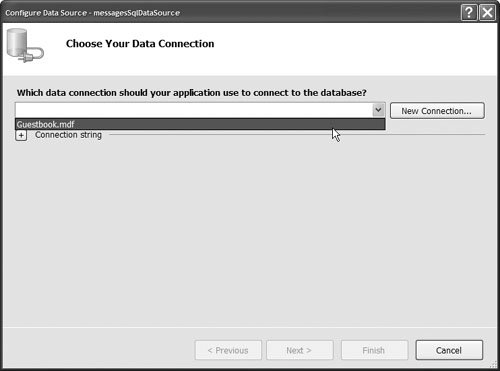
The Configure the Select Statement screen (Fig. 21.35) allows you to specify which data the SqlDataSource should retrieve from the database. Your choices on this page design a SELECT statement, shown in the bottom pane of the dialog. The Name drop-down list identifies a table in the database. The Guestbook database contains only one table named Messages, which is selected by default. In the Columns pane, click the checkbox marked with an asterisk (*) to indicate that you want to retrieve the data from all the columns in the Message table. Click the Advanced button, then check the box next to Generate UPDATE, INSERT and DELETE statements. This configures the SqlDataSource control to allow us to insert new data into the database. We discuss inserting new guestbook entries based on users' form submissions shortly. Click OK, then click Next > to continue the Configure Data Source wizard.
Figure 21.35. Configuring the SELECT statement used by the SqlDataSource to retrieve data.
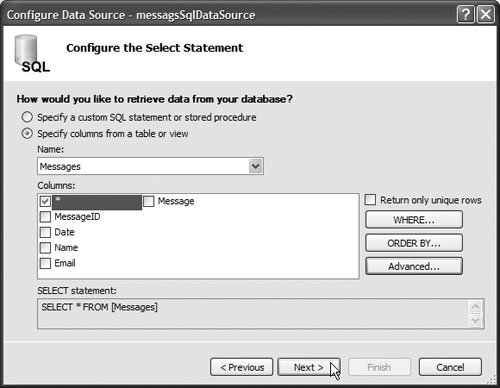
The next screen of the wizard allows you to test the query that you just designed. Click Test Query to preview the data that will be retrieved by the SqlDataSource (shown in Fig. 21.36).
Figure 21.36. Previewing the data retrieved by the SqlDataSource.
(This item is displayed on page 1114 in the print version)
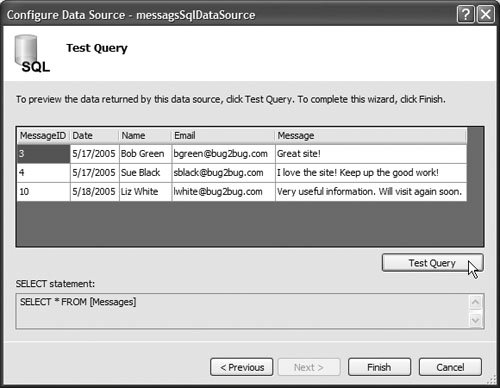
Finally, click Finish to complete the wizard. Notice that a control named messagesSqlDataSource now appears on the Web Form directly below the GridView (Fig. 21.37). This control is represented in Design mode as a gray box containing its type and name. This control will not appear on the Web pagethe gray box simply provides a way to manipulate the control visually through Design mode. Also notice that the GridView now has column headers that correspond to the columns in the Messages table and that the rows each contain either a number (which signifies an autoincremented column) or abc (which indicates string data). The actual data from the Guestbook database file will appear in these rows when the ASPX file is executed and viewed in a Web browser.
Figure 21.37. Design mode displaying SqlDataSource control for a GridView.
(This item is displayed on page 1114 in the print version)
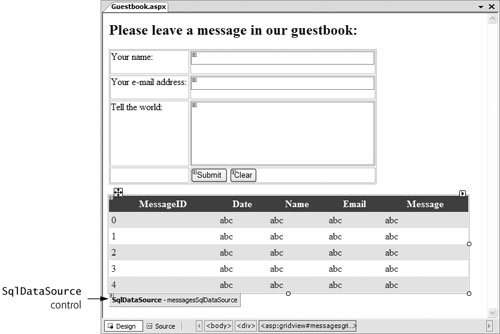
Step 6: Modifying the Columns of the Data Source Displayed in the GridView
It is not necessary for site visitors to see the MessageID column when viewing past guestbook entriesthis column is merely a unique primary key required by the Messages table within the database. Thus, we modify the GridView so that this column does not display on the Web Form. In the GridView Tasks smart tag menu, click Edit Columns. In the resulting Fields dialog (Fig. 21.38), select MessageID in the Selected fields pane, then click the X. This removes the MessageID column from the GridView. Click OK to return to the main IDE window. The GridView should now appear as in Fig. 21.33.
Figure 21.38. Removing the MessageID column from the GridView.
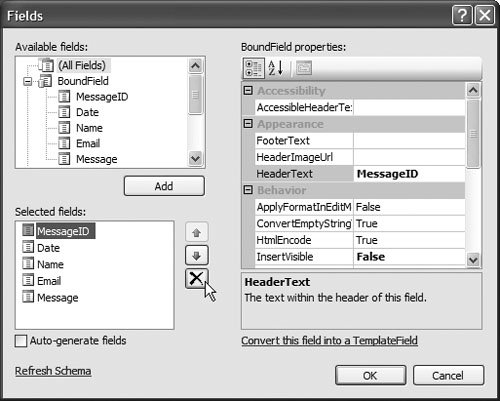
Step 7: Modifying the Way the SqlDataSource Control Inserts Data
When you create a SqlDataSource in the manner described here, it is configured to permit INSERT SQL operations against the database table from which it gathers data. You must specify the values to insert either programmatically or through other controls on the Web Form. In this example, we wish to insert the data entered by the user in the nameTextBox, emailTextBox and messageTextBox controls. We also want to insert the current datewe will specify the date to insert programmatically in the code-behind file, which we present shortly.
To configure the SqlDataSource to allow such an insertion, click the ellipsis button next to the InsertQuery property of the messagesSqlDataSource control in the Properties window. The Command and Parameter Editor (Fig. 21.39) that appears displays the INSERT command used by the SqlDataSource control. This command contains parameters @Date, @Name, @Email and @Message. You must provide values for these parameters before they are inserted into the database. Each parameter is listed in the Parameters section of the Command and Parameter Editor. Because we will set the Date parameter programmatically, we do not modify it here. For each of the remaining three parameters, select the parameter, then select Control from the Parameter source drop-down list. This indicates that the value of the parameter should be taken from a control. The ControlID drop-down list contains all the controls on the Web Form. Select the appropriate control for each parameter, then click OK. Now the SqlDataSource is configured to insert the user's name, e-mail address and message in the Messages table of the Guestbook database. We show how to set the date parameter and initiate the insert operation when the user clicks Submit shortly.
Figure 21.39. Setting up INSERT parameters based on control values.
(This item is displayed on page 1116 in the print version)
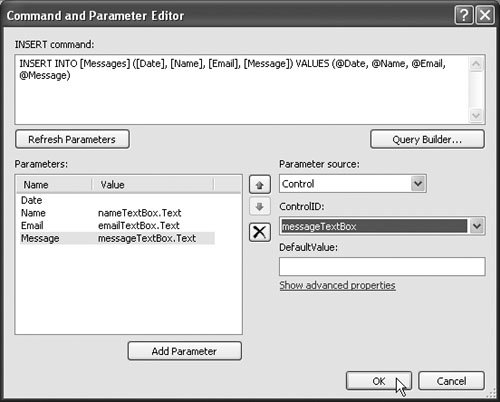
ASPX File for a Web Form That Interacts with a Database
The ASPX file generated by the guestbook GUI (and messagesSqlDataSource control) is shown in Fig. 21.40. This file contains a large amount of generated markup. We discuss only those parts that are new or noteworthy for the current example. Lines 2058 contain the XHTML and ASP.NET elements that comprise the form that gathers user input. The GridView control appears in lines 6187. The start tag (lines 6165) contains properties that set various aspects of the GridView's appearance and behavior, such as whether grid lines should be displayed between rows and columns. The DataSourceID property identifies the data source that is used to fill the GridView with data at runtime. Lines 6676 contain nested elements that define the styles used to format the GridView's rows. The IDE configured these styles based on your selection of the Simple style in the Auto Format dialog for the GridView.
Figure 21.40. ASPX file for the guestbook application.
Lines 7786 define the Columns that appear in the GridView. Each column is represented as a BoundField, because the values in the columns are bound to values retrieved from the data source (i.e., the Messages table of the Guestbook database). The DataField property of each BoundField identifies the column in the data source to which the column in the GridView is bound. The HeaderText property indicates the text that appears as the column header. By default, this is the name of the column in the data source, but you can change this property as desired.
The messagesSqlDataSource is defined by the markup in lines 89120 in Fig. 21.40. Lines 9091 contain a ConnectionString property, which indicates the connection through which the SqlDataSource control interacts with the database. The value of this property uses an ASP.NET expression, delimited by <%$ and %>, to access the GuestbookConnectionString stored in the ConnectionStrings section of the application's Web.config configuration file. Recall that we created this connection string earlier in this section using the Configure Data Source wizard.
Line 92 defines the SqlDataSource's SelectCommand property, which contains the SELECT SQL statement used to retrieve the data from the database. As determined by our actions in the Configure Data Source wizard, this statement retrieves the data in all the columns in all the rows of the Messages table. Lines 93100 define the DeleteCommand, InsertCommand and UpdateCommand properties, which contain the DELETE, INSERT and UPDATE SQL statements, respectively. These were also generated by the Configure Data Source wizard. In this example, we use only the InsertCommand. We discuss invoking this command shortly.
Notice that the SQL commands used by the SqlDataSource contain several parameters (prefixed with @). Lines 101119 contain elements that define the name, the type and, for some parameters, the source of the parameter. Parameters that are set programmatically are defined by Parameter elements containing Name and Type properties. For example, line 112 defines the Date parameter of Type String. This corresponds to the @Date parameter in the InsertCommand (line 97). Parameters that obtain their values from controls are defined by ControlParameter elements. Lines 113118 contain markup that sets up the relationships between the INSERT parameters and the Web Form's TextBoxes. We established these relationships in the Command and Parameter Editor (Fig. 21.39). Each ControlParameter contains a ControlID property indicating the control from which the parameter gets its value. The PropertyName specifies the property that contains the actual value to be used as the parameter value. The IDE sets the PropertyName based on the type of control specified by the ControlID (indirectly via the Command and Parameter Editor). In this case, we use only TextBoxes, so the PropertyName of each ControlParameter is Text (e.g., the value of parameter @Name comes from nameTextBox.Text). However, if we were using a DropDownList, for example, the PropertyName would be SelectedValue.
21.7.2. Modifying the Code-Behind File for the Guestbook Application
After building the Web Form and configuring the data controls used in this example, double click the Submit and Clear buttons to create their corresponding Click event handlers in the Guestbook.aspx.cs code-behind file (Fig. 21.41). The IDE generates empty event handlers, so we must add the appropriate code to make these buttons work properly. The event handler for clearButton (lines 4348) clears each TextBox by setting its Text property to an empty string. This resets the form for a new guestbook submission.
Figure 21.41. Code-behind file for the guestbook application.
(This item is displayed on page 1121 in the print version)
1 // Fig. 21.41: Guestbook.aspx.cs
2 // Code-behind file that defines event handlers for the guestbook.
3 using System;
4 using System.Data;
5 using System.Configuration;
6 using System.Web;
7 using System.Web.Security;
8 using System.Web.UI;
9 using System.Web.UI.WebControls;
10 using System.Web.UI.WebControls.WebParts;
11 using System.Web.UI.HtmlControls;
12
13 public partial class Guestbook : System.Web.UI.Page
14 {
15 // Submit Button adds a new guestbook entry to the database,
16 // clears the form and displays the updated list of guestbook entries
17 protected void submitButton_Click( object sender, EventArgs e )
18 {
19 // create a date parameter to store the current date
20 System.Web.UI.WebControls.Parameter date =
21 new System.Web.UI.WebControls.Parameter(
22 "Date", TypeCode.String, DateTime.Now.ToShortDateString() );
23
24 // set the @Date parameter to the date parameter
25 messagesSqlDataSource.InsertParameters.RemoveAt( 0 );
26 messagesSqlDataSource.InsertParameters.Add( date );
27
28 // execute an INSERT SQL statement to add a new row to the
29 // Messages table in the Guestbook database that contains the
30 // current date and the user's name, e-mail address and message
31 messagesSqlDataSource.Insert();
32
33 // clear the TextBoxes
34 nameTextBox.Text = "";
35 emailTextBox.Text = "";
36 messageTextBox.Text = "";
37
38 // update the GridView with the new database table contents
39 messagesGridView.DataBind();
40 } // end method submitButton_Click
41
42 // Clear Button clears the Web Form's TextBoxes
43 protected void clearButton_Click( object sender, EventArgs e )
44 {
45 nameTextBox.Text = "";
46 emailTextBox.Text = "";
47 messageTextBox.Text = "";
48 } // end method clearButton_Click
49 } // end class Guestbook
|
Lines 1740 contain the event-handling code for submitButton, which adds the user's information to the Messages table of the Guestbook database. Recall that we configured messagtesSqlDataSource's INSERT command to use the values of the TextBoxes on the Web Form as the parameter values inserted into the database. We have not yet specified the date value to be inserted, though. Lines 2022 assign a string representation of the current date (e.g., "5/27/05") to a new object of type Parameter. This Parameter object is identified as "Date" and is given the current date as a default value. The SqlDataSource's InsertParameters collection contains an item named Date, which we Remove in line 25 and replace in line 26 by Adding our date parameter. Invoking SqlDataSource method Insert in line 31 executes the INSERT command against the database, thus adding a row to the Messages table. After the data is inserted into the database, lines 3436 clear the TextBoxes, and line 39 invokes messagesGridView's DataBind method to refresh the data that the GridView displays. This causes messagesSqlDataSource (the data source of the GridView) to execute its SELECT command to obtain the Messages table's newly updated data.
Preface
Index
Introduction to Computers, the Internet and Visual C#
- Introduction
- What Is a Computer?
- Computer Organization
- Early Operating Systems
- Personal Computing, Distributed Computing and Client/Server Computing
- Hardware Trends
- Microsofts Windows® Operating System
- Machine Languages, Assembly Languages and High-Level Languages
- C#
- C, C++, Java and Visual Basic
- Other High-Level Languages
- The Internet and the World Wide Web
- Extensible Markup Language (XML)
- Microsofts .NET
- The .NET Framework and the Common Language Runtime
- Test-Driving a C# Application
- Software Engineering Case Study: Introduction to Object Technology and the UML
- Wrap-Up
- Web Resources
- Summary
- Terminology
- Self-Review Exercises
- Exercises
Introduction to the Visual C# 2005 Express Edition IDE
- Introduction
- Overview of the Visual Studio 2005 IDE
- Menu Bar and Toolbar
- Navigating the Visual Studio 2005 IDE
- Using Help
- Using Visual Programming to Create a Simple Program Displaying Text and an Image
- Wrap-Up
- Web Resources
- Summary
- Terminology
- Self-Review Exercises
- Exercises
Introduction to C# Applications
- Introduction
- A Simple C# Application: Displaying a Line of Text
- Creating Your Simple Application in Visual C# Express
- Modifying Your Simple C# Application
- Formatting Text with Console.Write and Console.WriteLine
- Another C# Application: Adding Integers
- Memory Concepts
- Arithmetic
- Decision Making: Equality and Relational Operators
- (Optional) Software Engineering Case Study: Examining the ATM Requirements Document
- Wrap-Up
- Summary
- Terminology
- Self-Review Exercises
- Exercises
Introduction to Classes and Objects
- Introduction
- Classes, Objects, Methods, Properties and Instance Variables
- Declaring a Class with a Method and Instantiating an Object of a Class
- Declaring a Method with a Parameter
- Instance Variables and Properties
- UML Class Diagram with a Property
- Software Engineering with Properties and set and get Accessors
- Value Types vs. Reference Types
- Initializing Objects with Constructors
- Floating-Point Numbers and Type decimal
- (Optional) Software Engineering Case Study: Identifying the Classes in the ATM Requirements Document
- Wrap-Up
- Summary
- Terminology
- Self-Review Exercises
- Exercises
Control Statements: Part 1
- Introduction
- Algorithms
- Pseudocode
- Control Structures
- if Single-Selection Statement
- if...else Double-Selection Statement
- while Repetition Statement
- Formulating Algorithms: Counter-Controlled Repetition
- Formulating Algorithms: Sentinel-Controlled Repetition
- Formulating Algorithms: Nested Control Statements
- Compound Assignment Operators
- Increment and Decrement Operators
- Simple Types
- (Optional) Software Engineering Case Study: Identifying Class Attributes in the ATM System
- Wrap-Up
- Summary
- Terminology
- Self-Review Exercises
- Exercises
Control Statements: Part 2
- Introduction
- Essentials of Counter-Controlled Repetition
- for Repetition Statement
- Examples Using the for Statement
- do...while Repetition Statement
- switch Multiple-Selection Statement
- break and continue Statements
- Logical Operators
- Structured Programming Summary
- (Optional) Software Engineering Case Study: Identifying Objects States and Activities in the ATM System
- Wrap-Up
- Summary
- Terminology
- Self-Review Exercises
- Exercises
Methods: A Deeper Look
- Introduction
- Packaging Code in C#
- static Methods, static Variables and Class Math
- Declaring Methods with Multiple Parameters
- Notes on Declaring and Using Methods
- Method Call Stack and Activation Records
- Argument Promotion and Casting
- The Framework Class Library
- Case Study: Random-Number Generation
- Case Study: A Game of Chance (Introducing Enumerations)
- Scope of Declarations
- Method Overloading
- Recursion
- Passing Arguments: Pass-by-Value vs. Pass-by-Reference
- (Optional) Software Engineering Case Study: Identifying Class Operations in the ATM System
- Wrap-Up
- Summary
- Terminology
- Self-Review Exercises
- Exercises
Arrays
- Introduction
- Arrays
- Declaring and Creating Arrays
- Examples Using Arrays
- Case Study: Card Shuffling and Dealing Simulation
- foreach Statement
- Passing Arrays and Array Elements to Methods
- Passing Arrays by Value and by Reference
- Case Study: Class GradeBook Using an Array to Store Grades
- Multidimensional Arrays
- Case Study: Class GradeBook Using a Rectangular Array
- Variable-Length Argument Lists
- Using Command-Line Arguments
- (Optional) Software Engineering Case Study: Collaboration Among Objects in the ATM System
- Wrap-Up
- Summary
- Terminology
- Self-Review Exercises
- Exercises
- Special Section: Building Your Own Computer
Classes and Objects: A Deeper Look
- Introduction
- Time Class Case Study
- Controlling Access to Members
- Referring to the Current Objects Members with the this Reference
- Indexers
- Time Class Case Study: Overloaded Constructors
- Default and Parameterless Constructors
- Composition
- Garbage Collection and Destructors
- static Class Members
- readonly Instance Variables
- Software Reusability
- Data Abstraction and Encapsulation
- Time Class Case Study: Creating Class Libraries
- internal Access
- Class View and Object Browser
- (Optional) Software Engineering Case Study: Starting to Program the Classes of the ATM System
- Wrap-Up
- Summary
- Terminology
- Self-Review Exercises
- Exercises
Object-Oriented Programming: Inheritance
- Introduction
- Base Classes and Derived Classes
- protected Members
- Relationship between Base Classes and Derived Classes
- Constructors in Derived Classes
- Software Engineering with Inheritance
- Class object
- Wrap-Up
- Summary
- Terminology
- Self-Review Exercises
- Exercises
Polymorphism, Interfaces & Operator Overloading
- Introduction
- Polymorphism Examples
- Demonstrating Polymorphic Behavior
- Abstract Classes and Methods
- Case Study: Payroll System Using Polymorphism
- sealed Methods and Classes
- Case Study: Creating and Using Interfaces
- Operator Overloading
- (Optional) Software Engineering Case Study: Incorporating Inheritance and Polymorphism into the ATM System
- Wrap-Up
- Summary
- Terminology
- Self-Review Exercises
- Exercises
Exception Handling
- Introduction
- Exception Handling Overview
- Example: Divide by Zero Without Exception Handling
- Example: Handling DivideByZeroExceptions and FormatExceptions
- .NET Exception Hierarchy
- finally Block
- Exception Properties
- User-Defined Exception Classes
- Wrap-Up
- Summary
- Terminology
- Self-Review Exercises
- Exercises
Graphical User Interface Concepts: Part 1
- Introduction
- Windows Forms
- Event Handling
- Control Properties and Layout
- Labels, TextBoxes and Buttons
- GroupBoxes and Panels
- CheckBoxes and RadioButtons
- PictureBoxes
- ToolTips
- NumericUpDown Control
- Mouse-Event Handling
- Keyboard-Event Handling
- Wrap-Up
- Summary
- Terminology
- Self-Review Exercises
- Answers To Self-Review Exercises
- Exercises
Graphical User Interface Concepts: Part 2
- Introduction
- Menus
- MonthCalendar Control
- DateTimePicker Control
- LinkLabel Control
- ListBox Control
- CheckedListBox Control
- ComboBox Control
- TreeView Control
- ListView Control
- TabControl Control
- Multiple Document Interface (MDI) Windows
- Visual Inheritance
- User-Defined Controls
- Wrap-Up
- Summary
- Terminology
- Self-Review Exercises
- Exercises
Multithreading
- Introduction
- Thread States: Life Cycle of a Thread
- Thread Priorities and Thread Scheduling
- Creating and Executing Threads
- Thread Synchronization and Class Monitor
- Producer/Consumer Relationship without Thread Synchronization
- Producer/Consumer Relationship with Thread Synchronization
- Producer/Consumer Relationship: Circular Buffer
- Multithreading with GUIs
- Wrap-Up
- Summary
- Terminology
- Self-Review Exercises
- Exercises
Strings, Characters and Regular Expressions
- Introduction
- Fundamentals of Characters and Strings
- string Constructors
- string Indexer, Length Property and CopyTo Method
- Comparing strings
- Locating Characters and Substrings in strings
- Extracting Substrings from strings
- Concatenating strings
- Miscellaneous string Methods
- Class StringBuilder
- Length and Capacity Properties, EnsureCapacity Method and Indexer of Class StringBuilder
- Append and AppendFormat Methods of Class StringBuilder
- Insert, Remove and Replace Methods of Class StringBuilder
- Char Methods
- Card Shuffling and Dealing Simulation
- Regular Expressions and Class Regex
- Wrap-Up
- Summary
- Terminology
- Self-Review Exercises
- Exercises
Graphics and Multimedia
- Introduction
- Drawing Classes and the Coordinate System
- Graphics Contexts and Graphics Objects
- Color Control
- Font Control
- Drawing Lines, Rectangles and Ovals
- Drawing Arcs
- Drawing Polygons and Polylines
- Advanced Graphics Capabilities
- Introduction to Multimedia
- Loading, Displaying and Scaling Images
- Animating a Series of Images
- Windows Media Player
- Microsoft Agent
- Wrap-Up
- Summary
- Terminology
- Self-Review Exercises
- Exercises
Files and Streams
- Introduction
- Data Hierarchy
- Files and Streams
- Classes File and Directory
- Creating a Sequential-Access Text File
- Reading Data from a Sequential-Access Text File
- Serialization
- Creating a Sequential-Access File Using Object Serialization
- Reading and Deserializing Data from a Sequential-Access Text File
- Wrap-Up
- Summary
- Terminology
- Self-Review Exercises
- Exercises
Extensible Markup Language (XML)
- Introduction
- XML Basics
- Structuring Data
- XML Namespaces
- Document Type Definitions (DTDs)
- W3C XML Schema Documents
- (Optional) Extensible Stylesheet Language and XSL Transformations
- (Optional) Document Object Model (DOM)
- (Optional) Schema Validation with Class XmlReader
- (Optional) XSLT with Class XslCompiledTransform
- Wrap-Up
- Web Resources
- Summary
- Terminology
- Self-Review Exercises
- Exercises
Database, SQL and ADO.NET
- Introduction
- Relational Databases
- Relational Database Overview: Books Database
- SQL
- ADO.NET Object Model
- Programming with ADO.NET: Extracting Information from a Database
- Querying the Books Database
- Programming with ADO.NET: Address Book Case Study
- Using a DataSet to Read and Write XML
- Wrap-Up
- Web Resources
- Summary
- Terminology
- Self-Review Exercises
- Exercises
ASP.NET 2.0, Web Forms and Web Controls
- Introduction
- Simple HTTP Transactions
- Multitier Application Architecture
- Creating and Running a Simple Web-Form Example
- Web Controls
- Session Tracking
- Case Study: Connecting to a Database in ASP.NET
- Case Study: Secure Books Database Application
- Wrap-Up
- Web Resources
- Summary
- Terminology
- Self-Review Exercises
- Exercises
Web Services
- Introduction
- .NET Web Services Basics
- Simple Object Access Protocol (SOAP)
- Publishing and Consuming Web Services
- Session Tracking in Web Services
- Using Web Forms and Web Services
- User-Defined Types in Web Services
- Wrap-Up
- Web Resources
- Summary
- Terminology
- Self-Review Exercises
- Exercises
Networking: Streams-Based Sockets and Datagrams
- Introduction
- Connection-Oriented vs. Connectionless Communication
- Protocols for Transporting Data
- Establishing a Simple TCP Server (Using Stream Sockets)
- Establishing a Simple TCP Client (Using Stream Sockets)
- Client/Server Interaction with Stream-Socket Connections
- Connectionless Client/Server Interaction with Datagrams
- Client/Server Tic-Tac-Toe Using a Multithreaded Server
- WebBrowser Control
- .NET Remoting
- Wrap-Up
- Summary
- Terminology
- Self-Review Exercises
- Exercises
Searching and Sorting
- Introduction
- Searching Algorithms
- Sorting Algorithms
- Wrap-Up
- Summary
- Terminology
- Self-Review Exercises
- Exercises
Data Structures
- Introduction
- Simple-Type structs, Boxing and Unboxing
- Self-Referential Classes
- Linked Lists
- Stacks
- Queues
- Trees
- Wrap-Up
- Summary
- Terminology
- Self-Review Exercises
- Exercises
Generics
- Introduction
- Motivation for Generic Methods
- Generic Method Implementation
- Type Constraints
- Overloading Generic Methods
- Generic Classes
- Notes on Generics and Inheritance
- Wrap-Up
- Summary
- Terminology
- Self-Review Exercises
- Exercises
Collections
- Introduction
- Collections Overview
- Class Array and Enumerators
- Non-Generic Collections
- Generic Collections
- Synchronized Collections
- Wrap-Up
- Summary
- Terminology
- Self-Review Exercises
- Exercises
Appendix A. Operator Precedence Chart
Appendix B. Number Systems
- B.1. Introduction
- B.2. Abbreviating Binary Numbers as Octal and Hexadecimal Numbers
- B.3. Converting Octal and Hexadecimal Numbers to Binary Numbers
- B.4. Converting from Binary, Octal or Hexadecimal to Decimal
- B.5. Converting from Decimal to Binary, Octal or Hexadecimal
- B.6. Negative Binary Numbers: Twos Complement Notation
- Summary
- Terminology
- Self-Review Exercises
- Exercises
Appendix C. Using the Visual Studio 2005 Debugger
- C.1. Introduction
- C.2. Breakpoints and the Continue Command
- C.3. The Locals and Watch Windows
- C.4. Controlling Execution Using the Step Into, Step Over, Step Out and Continue Commands
- C.5. Other Features
- C.6. Wrap-Up
- Summary
- Terminology
- Self-Review Exercises
Appendix D. ASCII Character Set
Appendix E. Unicode®
- E.1. Introduction
- E.2. Unicode Transformation Formats
- E.3. Characters and Glyphs
- E.4. Advantages/Disadvantages of Unicode
- E.5. Using Unicode
- E.6. Character Ranges
- Summary
- Terminology
- Self-Review Exercises
- Answers to Self-Review exercises
- Exercises
Appendix F. Introduction to XHTML: Part 1
- F.1. Introduction
- F.2. Editing XHTML
- F.3. First XHTML Example
- F.4. W3C XHTML Validation Service
- F.5. Headers
- F.6. Linking
- F.7. Images
- F.8. Special Characters and More Line Breaks
- F.9. Unordered Lists
- F.10. Nested and Ordered Lists
- F.11. Web Resources
Appendix G. Introduction to XHTML: Part 2
- G.1. Introduction
- G.2. Basic XHTML Tables
- G.3. Intermediate XHTML Tables and Formatting
- G.4. Basic XHTML Forms
- G.5. More Complex XHTML Forms
- G.6. Internal Linking
- G.7. Creating and Using Image Maps
- G.8. meta Elements
- G.9. frameset Element
- G.10. Nested framesets
- G.11. Web Resources
Appendix H. HTML/XHTML Special Characters
Appendix I. HTML/XHTML Colors
Appendix J. ATM Case Study Code
- Appendix J. ATM Case Study Code
- J.1. ATM Case Study Implementation
- J.2. Class ATM
- J.3. Class Screen
- J.4. Class Keypad
- J.5. Class CashDispenser
- J.6. Class DepositSlot
- J.7. Class Account
- J.8. Class BankDatabase
- J.9. Class Transaction
- J.10. Class BalanceInquiry
- J.11. Class Withdrawal
- J.12. Class Deposit
- J.13. Class ATMCaseStudy
- J.14. Wrap-Up
Appendix K. UML 2: Additional Diagram Types
Appendix L. Simple Types
Index
EAN: 2147483647
Pages: 600
